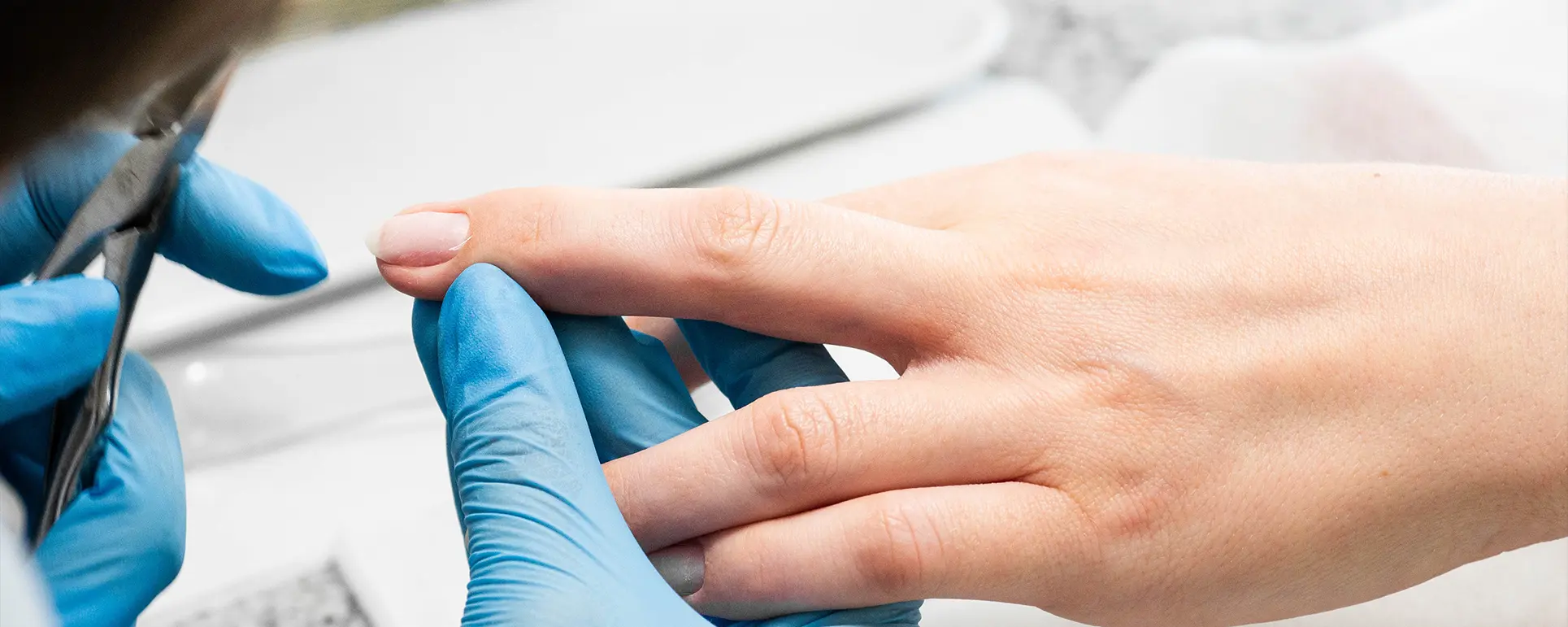Have you ever glanced down at your hands or feet and noticed a mysterious dark line running through one of your nails? For many people, this discovery can feel unsettling, sparking instant concern about whether it signals something serious. After all, our nails are not just cosmetic features they can also reveal important clues about our overall health.
While nail discolouration is relatively common and often harmless, a dark streak should never be ignored, particularly if it appears suddenly, looks unusual, or begins to change over time. In some cases, these marks may simply be the result of everyday issues such as a minor bump to the nail, increased melanin production, or even side effects from certain medications. In other situations, however, the same type of line could point to an underlying medical problem.
Doctors refer to this condition as longitudinal melanonychia a term used to describe brown, black, grey, or sometimes reddish streaks that run lengthwise along the nail. These streaks can be thin and subtle or wider and more noticeable. They may affect just one nail or several, depending on the cause. For individuals with darker skin tones, the presence of faint brownish lines on the nails can often be a normal occurrence. Still, even in these cases, monitoring changes is crucial.
The most concerning possibility associated with a new or changing dark line on the nail is subungual melanoma, a rare but aggressive form of skin cancer that develops beneath the nail plate. Because its early signs can look so similar to harmless streaks, it is often missed until the condition has progressed. That is why dermatologists stress the importance of paying attention to subtle changes in the nails and seeking professional advice when something doesn’t seem right.
It’s worth remembering that not every dark line is a cause for alarm. Many turn out to be benign, linked to lifestyle, genetics, or small injuries that eventually grow out with the nail. However, knowing when to take action is key. By understanding the potential causes and recognising red flags, you can protect yourself from unnecessary worry while ensuring that serious issues are not overlooked.
In this article, we’ll explore the various reasons a dark line may appear on your nail, the signs that suggest it could be something more serious, and the steps you should take if you notice one. With the right knowledge, you can strike the balance between staying cautious and avoiding undue panic.
Common Causes of Dark Lines on Nails

Dark lines on nails may look similar at first glance, but the underlying reasons can vary widely from harmless pigment changes to serious medical concerns. Here’s a closer look at the most frequent causes, how they appear, and when you should consider getting them checked.
1. Melanonychia
Melanonychia is a condition where pigmentation develops along the nail plate, usually appearing as a vertical streak that runs from the base of the nail to the tip. The colour may range from light brown to deep black, depending on how much melanin is produced.
For people with darker skin tones, melanonychia is often completely normal and can occur in multiple nails at once. In fact, studies show that more than 70% of individuals with African, Asian, or Hispanic backgrounds will develop these streaks at some point in their lives. In lighter-skinned individuals, however, the sudden appearance of melanonychia on a single nail may be more concerning.
Melanonychia is usually benign, but what matters most is how the line behaves over time. A thin, stable streak is less concerning than one that begins to widen, darken, or develop uneven edges. Because melanoma can also present as melanonychia, dermatologists often advise patients to have any new or changing streak assessed, regardless of skin tone.
It’s also worth noting that melanonychia can be influenced by age, hormonal changes, and even repeated minor trauma to the nails, such as from typing, playing instruments, or certain sports. These factors can stimulate the pigment-producing cells in the nail bed, creating streaks that might look concerning but are in fact harmless. Still, monitoring their development is essential, as early detection of unusual changes makes treatment easier and more effective.
Key points to remember about melanonychia:
- Appears as a vertical streak, ranging from light brown to deep black.
- Common and usually harmless in people with darker skin tones.
- More concerning when seen in lighter-skinned individuals on a single nail.
- Stable lines are less worrisome than those that widen or darken over time.
- New or changing streaks should always be checked by a dermatologist.
2. Trauma or Injury
Minor injuries are a very common cause of dark lines or streaks on nails. This happens when blood vessels beneath the nail break, leading to bleeding and visible discolouration what doctors call a subungual haematoma.
The appearance of these marks depends on the severity of the injury. A small bump may leave behind a thin reddish-brown line, while more significant trauma, like dropping something heavy on your toe, could create a larger black patch. These bruises usually move upward as the nail grows, gradually fading over weeks to months. Fingernails typically grow about 3 mm per month, while toenails grow more slowly, so bruises on toenails may take much longer to disappear.
One thing to watch for is whether the mark is moving as your nail grows. A true bruise will migrate towards the tip over time, but melanoma-related streaks tend to stay fixed at the base or expand instead of moving. If a line doesn’t behave like a typical bruise, it’s time to seek medical advice.
In addition, repetitive trauma from activities such as running, hiking, or wearing tight-fitting shoes can also cause streaks and bruises under the nails. Athletes, in particular, often experience this due to repeated stress on the nail bed. While these usually resolve on their own, protecting the nails and wearing properly fitted footwear can help reduce the chances of re-injury.
Key points to remember about trauma-related nail streaks:
- Caused by broken blood vessels under the nail (subungual haematoma).
- May appear as reddish-brown lines or dark patches.
- True bruises move upwards as the nail grows.
- Toenail bruises fade more slowly than fingernail ones.
- Fixed or widening lines should be evaluated by a dermatologist.
3. Fungal or Bacterial Infections
Infections can also alter the colour and structure of nails. Fungal infections (onychomycosis) usually cause yellowing, thickening, and brittleness, but some types of fungi can create darker streaks or spots as well. Over time, these nails may become crumbly or distorted, making daily activities uncomfortable.
Bacterial infections, such as those caused by Pseudomonas, can also cause nail discolouration. These often lead to greenish or blackish streaks under the nail, sometimes accompanied by pain, swelling, or pus if the infection is severe. People who frequently keep their hands in water like cleaners, dishwashers, or swimmers are more prone to developing such infections.
Unlike trauma, infections don’t grow out on their own. They typically require antifungal or antibacterial treatment prescribed by a doctor. If you notice streaks accompanied by changes in nail texture, pain, or swelling, it’s best to get them checked promptly.
It’s also worth noting that untreated infections can spread to surrounding nails or even the skin, leading to more widespread discomfort. Early treatment not only resolves the discolouration but also prevents permanent nail damage, which can sometimes occur if infections persist for months or years without care.
Key points to remember about nail infections:
- Fungal infections may cause yellowing, brittleness, or dark streaks.
- Bacterial infections (like Pseudomonas) can turn nails greenish or blackish.
- Common in people who keep hands or feet wet for long periods.
- Do not grow out on their own medical treatment is usually required.
- Untreated infections can spread and cause lasting nail damage.
4. Medications or Medical Conditions
Sometimes, the cause of dark lines lies within the body rather than the nail itself. Certain medications can stimulate pigment production in the nail matrix, leading to vertical streaks. This is often seen in patients undergoing chemotherapy, taking antimalarial drugs, or using specific antibiotics for extended periods.
In these cases, the pigmentation is usually harmless and may fade once the medication is discontinued. However, since medication-related changes can mimic melanoma, it’s important not to assume the cause without medical confirmation.
Dark nail streaks may also appear as part of broader medical conditions. For example:
- Addison’s disease (an adrenal gland disorder) can cause hyperpigmentation of the skin and nails.
- HIV has been linked to nail melanonychia, especially in patients on long-term antiretroviral therapy.
- Nutritional deficiencies, such as low levels of vitamin B12, may alter nail colour.
When pigmentation is linked to systemic illness, treating the underlying condition often improves the nail’s appearance.
5. Nail Melanoma
The rarest but most serious cause of dark lines on nails is nail melanoma, also known as subungual melanoma. Unlike other forms of melanoma that appear on sun-exposed skin, this type develops under the nail plate, making it harder to detect.
Warning signs include:
- A dark streak that is new or has suddenly appeared on a single nail.
- A line that widens over time, especially at the base.
- Uneven colouring, with areas that look darker, lighter, or blurred.
- Changes in the nail’s shape, such as cracking, splitting, or lifting.
- Pigmentation spreading to the surrounding skin (called Hutchinson’s sign).
Nail melanoma most commonly affects the thumb, big toe, or index finger. Because it progresses silently, many people dismiss the streak as a bruise or fungal infection until it has advanced. Unfortunately, delays in diagnosis can make treatment more difficult. That’s why dermatologists stress that any suspicious line especially one that doesn’t grow out or continues to evolve should be evaluated immediately.
When to See a Dermatologist

Not every dark streak on a nail is a cause for alarm, but there are certain signs that should always prompt a visit to a dermatologist. Since nails can reflect both local issues and systemic health problems, it’s better to be cautious. A dermatologist has the tools and expertise to distinguish between a harmless mark and a more serious condition. Early consultation provides peace of mind, and in rare cases where the cause is more concerning, it can make a life-saving difference.
Here are the key situations when you should seek professional help:
- The line is dark, wide, or increasing in size.
A faint, narrow streak that remains unchanged for years is usually less worrisome. But if the streak is very dark, starts to thicken, or gradually widens across the nail, this is a red flag. Unlike harmless pigmentation, which typically remains stable, lines associated with melanoma tend to evolve over time. Tracking these changes by taking photographs, for example can help your doctor assess whether the streak is suspicious. - The pigmentation extends to the surrounding skin (Hutchinson’s sign).
When the dark pigment is not confined to the nail plate but spills over into the cuticle or the skin beside the nail, it is known as Hutchinson’s sign. Dermatologists consider this one of the strongest warning indicators of nail melanoma. Even if the streak itself looks subtle, spreading pigment requires urgent evaluation. - The nail is painful, bleeding, or changing shape.
Harmless lines are usually asymptomatic. If the nail becomes tender, starts bleeding, or looks deformed splitting, lifting, or developing ridges this suggests something more serious than simple pigmentation. Pain and bleeding can indicate infection, but they may also be linked to more aggressive conditions like melanoma that alter the nail’s structure as they progress. - Multiple nails show sudden changes.
A single streak may be trauma or melanoma, but when several nails suddenly develop lines or discolouration at once, it often points to a different cause, such as fungal infections, medication side effects, or systemic illnesses like Addison’s disease or nutritional deficiencies. These conditions are not always dangerous but still require a professional diagnosis and tailored treatment. - The mark doesn’t behave like a bruise.
A bruise under the nail from an injury (subungual haematoma) typically grows out with the nail over weeks or months. If your streak stays fixed in place, refuses to grow out, or seems to get darker rather than lighter, it is unlikely to be a simple bruise. This is a strong signal that further investigation is needed.
Why Early Evaluation Matters
Many people delay seeing a dermatologist because they assume the line will resolve on its own, or they fear receiving bad news. The reality is that most nail streaks turn out to be benign or related to easily treatable causes. But if the streak is linked to nail melanoma, early detection can be life-saving. Studies show that melanoma under the nail is often diagnosed later than skin melanoma on other parts of the body, simply because patients and even doctors mistake it for something harmless.
What to Expect at Your Dermatology Appointment
If you decide to seek professional help, here’s what might happen during your visit:
- History and examination: The dermatologist will ask about when you first noticed the streak, whether it has changed, and if you have a history of injuries, medication use, or family history of melanoma.
- Dermatoscopy: Using a dermatoscope a special magnifying tool the doctor can look closely at the streak’s colour, borders, and patterns, which often reveal whether it’s benign or suspicious.
- Photographic monitoring: In some cases, if the line looks stable, your dermatologist may take detailed photos and ask you to return in a few months for comparison.
- Biopsy: If there are concerns about melanoma, the dermatologist may recommend a biopsy of the nail matrix (the part that produces nail growth). Though it may sound intimidating, this procedure is crucial for an accurate diagnosis and can help prevent delayed treatment.
The Bottom Line
Seeing a dermatologist doesn’t automatically mean bad news it means clarity. Whether the line is caused by a bruise, an infection, medication, or something more serious, getting a professional opinion ensures you’re not left guessing. And in the rare case that it does turn out to be melanoma, early detection gives you the best chance of effective treatment and recovery.
So, if you’ve noticed a new or changing dark line on your nail, don’t wait and worry book an appointment. A few minutes with a specialist can give you answers, reassurance, and, if needed, a clear treatment plan.
Final Thought: Your Nails Tell a Bigger Story
Dark lines on nails are not always serious, but caution is crucial. If you notice unusual or changing streaks, it’s important to consult a dermatologist in London for assessment and possible treatment. Prompt attention can help rule out melanoma and other serious conditions while providing guidance for minor causes.
Remember, your nails can act as small windows into your overall health. Paying attention to changes no matter how minor they seem can make a big difference in catching issues early and ensuring the best possible outcome.
References:
- Singal, A., Sonthalia, S. & Verma, P. (2020) “Melanonychia: Etiology, Diagnosis, and Treatment”, Indian Journal of Dermatology, 65(6), pp. 428–438. Available at: https://www.ncbi.nlm.nih.gov/pmc/articles/PMC7001389/
- Ricardo, J.W., et al. (2025) “Evaluation and diagnosis of longitudinal melanonychia”, Journal of the American Academy of Dermatology, [online ahead of print]. DOI: 10.1016/j.jaad.2025.02.075. Available at: https://pubmed.ncbi.nlm.nih.gov/40023404/
- Puckett, Y.P. & MacKenzie, D.N. (2023) “Subungual Melanoma”, StatPearls [Internet], Treasure Island (FL): StatPearls Publishing. Available at: https://www.ncbi.nlm.nih.gov/books/NBK482480/
- Di Chiacchio, N., et al. (2010) “Dermatologists’ Accuracy in Early Diagnosis of Melanoma of the Nail Matrix”, JAMA Dermatology, 146(4), pp. 382–387. Available at: https://jamanetwork.com/journals/jamadermatology/fullarticle/421241
- Aseri, J., Kumawat, K., Tamta, A., Bhargava, P. & Meena, R.S. (2022) “Basic Approach to Melanonychia: A Review”, International Journal of Research in Dermatology, 8(4), pp. 426–432. Available at: http://www.ijord.com/index.php/ijord/article/download/1566/883/6668
